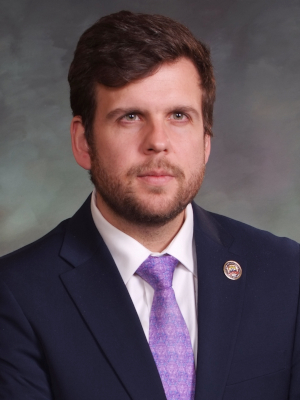2024-09
EMERGENCY RESOLUTION:
Declaring a Housing Emergency
and Calling for Multi-Government Initiatives on Housing Construction, Access, Security and Affordability
Sponsored by
Rep. Javier Mabrey (CO), Sen. Anna Hernández (AZ), Sen. Cristina Castro (IL),
Asw. Yvonne Lopez (NJ) and Rep. Veronica Paiz (MI)
Reported to the Caucus by the NHCSL Housing Task Force
Asw. Yvonne López (NJ), Chair
Unanimously approved by the NHCSL Executive Committee on behalf of the entire Caucus on July 13, 2024
WHEREAS, last year, in Resolution 2023-13, the National Hispanic Caucus of State Legislators (NHCSL) first addressed the housing supply deficit of approximately 2.3 million units, which increases to 6.5 million homes when not including long-term rental units; underscoring that Hispanic Americans are more likely to suffer from housing insecurity, making up 24.1% of the US homeless population; and,
WHEREAS, in that resolution, the NHCSL “committed to supporting policies that lead to greater housing availability and affordability, helping to prevent the displacement of vulnerable groups; and,
WHEREAS, the recent Supreme Court holding in City of Grants Pass, Oregon v. Johnson, 144 S. Ct. 679 (2024), which allows state and local governments to criminalize homelessness, elevates the housing crisis into a national emergency; and,
-
The American Dream is now unachievable for young Americans. The average American can no longer afford the typical American home.
WHEREAS, according to the NY Fed SCE Housing Survey,[1] and despite significant efforts by the Biden-Harris administration[2] to increase the housing supply and lower rental costs, the gap between renters under 50 years-old who would prefer to be homeowners and those who expect to actually become homeowners at some point in their lives has almost tripled from a historical norm of between 8% and 12%[3] to over 27% this year; and,
WHEREAS, for the first time since the survey started, fewer than half (49%) of young renters now believe they will ever become homeowners, down from a high of 69% in 2019;[4] and,
WHEREAS, all the above means that more than one out of every three (1/3) young renters who want to buy a home in the future now believe they will never be able to. That is up from only one out of nine (1/9) in 2015 and one out of six (1/6) in 2022, a powerful indicator that, in just two years, a significant portion of young Americans lost hope of ever achieving the American Dream,[5] with the most significantly impacted being Hispanic, Black, mixed-race and LGBTQ Americans;[6] and,
WHEREAS, economic reality bears out the gap in their belief in achieving homeownership. according to Zillow, as of May 2024, the monthly mortgage payment on the typical US home has more than doubled since pre-pandemic (up 115.3%);[7] and, the monthly rent has increased by 32.1% (up 39.1% for single-family and up 25.9% for multifamily).[8] In fact, according to the Urban Institute, “the gap in the homeownership rate between black and white families in the US is bigger today than it was when it was legal to refuse to sell someone a home because of the color of their skin” before the 1968 Fair Housing Act;[9] and,
WHEREAS, also according to Zillow, median New York earners would need to save for 27 years to amass the down payment needed to then afford the remaining cost of the typical home in their city (mortgage payment, insurance, and property taxes). Median Los Angeles, earners would need to save for 36 years. In fact, a typical home is affordable to a median-income household with 20% down or less in only 10 of the 50 biggest U.S. markets, but only if they have no other debt which is far from the reality of most Americans;[10] and,
WHEREAS, the housing affordability crisis is not only affecting the poorest among us. According to a Harvard study, “among renters, cost-burden rates have increased across the income spectrum” with numbers at an all-time high, making it impossible to cover basic living expenses, let alone save for a down payment. “Half of all renter households—22.4 million—were cost burdened at last measure in 2022, up 2 million since 2019 and the highest number on record. Likewise, the number of severely cost-burdened renter households—those spending more than half of household income on housing and utilities—also hit a new high of 12.1 million in 2022, up 1.5 million from pre-pandemic levels;”[11] and,
WHEREAS, Hispanic and Black Americans face the added barrier of an income gap, that is consistent regardless of education, and helps explain why they are cost-burdened at disproportionately high rates (57% of Black and 54% Hispanic renter households are cost burdened, with even more disproportionate impact at lower incomes);[12] and,
WHEREAS, cost burdens the housing affordability crisis is not only affecting renters and the young. Nearly one in four homeowner households (23.2 percent), almost 20 million households, are cost-burdened,[13] “including 27.4 percent of homeowners age 65 and over;”[14] and,
WHEREAS, the housing affordability crisis is impacting households with incomes well into the six figures. According to Zillow, before the pandemic, the median income (then $66,000) was more than Americans needed to earn (then $59,000) to comfortably afford the typical home. Now, the median income (around $81,000) may allow Americans to afford rent,[15] but places them far from being able to buy. While Americans making less than $100,000 can afford homes in a few markets, they need to make at least $106,000 to afford the typical home nationwide, an 80% increase from 2020.[16] In the major coastal cities of the Northeast and the West, the income needed is close to $200,000 or up to $300,000.[17] In fact, there are currently 550 U.S. cities where the typical home value is $1 million or more, up from 491 cities just a year ago;[18] and,
WHEREAS, as of June 2024, shelter inflation, a measure of growth in the cost of rent,[19] is the primary driver of unwanted inflation and “the main impediment to the consumer price index falling back to the Federal Reserve’s target” rate of 2%;[20] and,
-
The construction industry’s discriminatory practices and past administrations’ punitive policies against immigrants, caused a million-worker gap in construction trades, decreasing housing construction
WHEREAS, in a survey by the National Association of Home Builders, seventy three (73%) of homebuilders cited the cost and availability of labor as a major challenge to development, second only to high interest rates as a challenge;[21] and,
WHEREAS, according to the Harvard Joint Center for Housing Studies, “there are roughly one million fewer workers in the construction trades[22] than there were at the time of the last housing boom in 2007, which has contributed to project delays, rising costs, and other challenges.”[23] This million-worker gap is primarily due to difficulties attracting young people, women and people of color, and a decline in new immigrant trades workers;[24] and,
WHEREAS, close to half of the skilled labor shortage in the construction industry was due to “years of slowing gains from immigration.”[25] The apparent culprit was the immigration policy shift from returns (migrants returned at the border without legal penalties) to removals (migrants returned after court order and often penalized), started at the end of the George W. Bush administration,[26] ramped up by the Obama administration[27] and continued by the Trump administration,[28] with the underlying reasoning “to deter illegal border crossing and remove unauthorized immigrants before they become integrated into U.S. communities,”[29] and which the Trump administration then also used against long-time residents originally protected by Obama.[30] This policy shift led to “the annual flow of new immigrants into the construction industry [slowing] down significantly, averaging 45,000 annually from 2010–2019 compared with 88,000 annually on average from 2003–2009.”[31] Experts underscore that “complimentary immigration policies would help to ensure that the trades workforce avoids future costly gaps in labor supply;”[32] and,
WHEREAS, the National Hispanic Caucus of State Legislators first alerted policymakers to the retention troubles facing the construction industry in Resolution 2017-13, highlighting the hazing and discrimination in construction apprenticeships facing those same groups, young women and people of color, leading almost half to cancel them. In it, NHCSL:
- called on the U.S. Department of Labor and the President’s Task Force on Apprenticeships to take note of the high rates of cancellation and enact initiatives to assist apprentices in completing their apprenticeships by better identifying problems on apprenticeship sites, problems in academic courses, personal struggles that can prevent an apprentice, or discrimination that can prevent an apprentice from completing their program;
- called upon state legislators and state labor departments to enact legislation or regulations whereby all apprenticeship programs with more than one apprentice are required to have an affirmative action program and to adhere to more rigid diversity requirements than currently required under Federal regulations; and,
- called work-based learning allowing for students in high school to earn credit towards graduation for their time as an apprentice within a business; to work with business to construct a gold standard curriculum for apprentices, benefiting both employer and apprentices; and to encourage Apprenticeship Diplomas upon graduating high school; and,
WHEREAS, the National Hispanic Caucus of State Legislators further alerted policymakers to the human resources crisis in the construction industry in Resolution 2023-02, Combatting Wage Theft with Particular emphasis in the Construction Industry, in which NHCSL called for regulations and legislation to curb and punish wage theft, including by holding direct or general contractors liable to workers for wages left unpaid by subcontractors; and highlighted that:
- 20 percent of construction industry workers suffer from payroll fraud,
- 39 percent of families of construction workers nationwide rely on state social safety net programs, over three times higher than the rate of any other industry of workers, and,
- undocumented immigrants are often the first to be taken advantage of on job sites due to inaccessibility of proper employment and wage policies; and,
-
Institutional investors are pricing-out families from buying or renting
WHEREAS, investors have purchased single-family homes at an elevated rate starting in 2021.[33] That year, those investors (large corporations, private equity firms, local companies or wealthy individuals that generally don’t live in the properties they are buying) bought one in every seven homes sold,[34] with a greater proportion of purchases in neighborhoods with greater concentration of Hispanic, Black and Asian residents,[35] and up to 30% of all homes in neighborhoods where a majority of residents are Black, significantly affecting tenants and potential homeowners;[36] and,
WHEREAS, the Federal Trade Commission and the US Department of Justice recently supported a tenant lawsuit alleging price fixing by algorithm which has exacerbated the “considerable leverage these firms already have over their renters” with “landlords reportedly using software like ‘RENTMaximizer’ and similar products to determine rents for tens of millions of apartments across the country;”[37] and,
-
Policies unduly restricting zoning and allowing diversion of housing for non-housing use have worsened the crisis
WHEREAS, in Resolution 2023-13, NHCSL concluded that absentee-host short term rentals have had a significant negative effect on housing affordability by severely limiting the expected housing supply and called on state legislatures to adopt laws that prohibit the use of residential properties as absentee-host short term rentals (STRs), but allow STRs in housing units in which the host is a permanent resident; and,
WHEREAS, in that resolution, the NHCSL also called for legislation in places where prohibiting absentee-host short term rentals is not feasible, to regulate absentee-host short-term rentals, subjecting STR owners to the same health and safety duties as hotels, ensuring they pay commercial utility rates and property taxes, and limiting their number in any given neighborhood; and,
WHEREAS, in a survey by the National Association of Home Builders, half (49%) of homebuilders also cited difficulties obtaining zoning or permit approvals as a major challenge to development;[38] and,
WHEREAS, according to Harvard’s Joint Center for Housing Studies, “local zoning and regulatory barriers frequently impede new construction by restricting or deterring the types, amount, and density of housing that can be built. These regulations can take many forms, including exclusionary single-family zoning, large minimum lot sizes, and excessive parking requirements;”[39] and,
WHEREAS, for example, “the majority of land in cities across the country is currently zoned exclusively for single-family homes.”[40] And, “43 percent of jurisdictions have a minimum lot size of at least one acre in any residential district, nearly 10 percent don’t allow multifamily housing by right in any district, and a median of 1.8 parking spaces are required per new unit, on average;”[41] and,
WHEREAS, in order to address the negative impact of those policies, “some local areas have changed zoning to allow a range of housing types [including accessory dwelling units (ADLs)][42] on land previously zoned exclusively for single-family development, and a handful of states[43] have preempted local zoning codes to do so;”[44] and,
WHEREAS, “Massachusetts now requires the 177 jurisdictions served by public transit to designate at least one zone that allows multifamily buildings and higher-density construction without special approvals”[45] and some smaller jurisdictions in that state have revised zoning requirements to allow manufactured housing;[46] and,
-
The best federal home financing programs exclude too many on the basis of simply living in a city
WHEREAS, following the 2008 housing bubble collapse and Great Recession, federal policies made it harder for potential buyers to buy housing by requiring mortgage insurance for smaller down payments and tightening eligibility; and,
WHEREAS, the best federal financing programs, like the USDA Rural Development Section 502 Single Family Housing Guaranteed Loan Program, which does not require mortgage insurance, and the USDA Rural Development Section 502 Direct Loan Program, which allows lower income applicants to buy housing, are restricted to housing in rural areas only, despite the urgent need for such relief in urban and suburban areas.
-
Conclusions
THEREFORE BE IT RESOLVED, that the National Hispanic Caucus of State Legislators (NHCSL) declares, and calls on federal and state governments to also declare, a housing emergency in the United States to last until such time as the gap in the NY Fed SCE Housing Survey between renters under 50 years-old who want to own a home and those who believe they will ever become homeowners is 5% or less for three consecutive years, restoring the achievability of the American Dream; and,
BE IT FURTHER RESOLVED, that, in order to effectuate the goals of declaring the emergency, and while it lasts, NHCSL calls on all federal, state and local governments to enact and execute multi-pronged policy solutions to the housing access and affordability crisis, and to the asymptotic decline in expectations of the American Dream it has provoked, to, among other goals:
- at least double the rate of housing construction,
- train and add at least a million workers to the construction workforce, including through affordable trades education, increased apprenticeship promotion and protections and through appropriate immigration enticements, reinforcing needed diversity protections in all cases,
- prioritize transit-oriented infill housing in walkable neighborhoods and deprioritizing sprawl, revising zoning and other rules accordingly,
- repurpose public lands (including underused urban public properties) to build housing,
- prevent the repurposing of housing units as vacation rentals and release repurposed housing units back into the housing supply,[47]
- reduce or eliminate the power of homeowners’ associations (HOAs) or similar entities to block or impair housing construction, access or affordability,
- reduce or eliminate government-imposed hurdles to housing affordability unless they are related to maintaining health, safety or fair wages,
- lower interest rates for federally guaranteed mortgages and make their users more able to compete for diverse homes, including fixer uppers, and promote and make available variable rate loans until interest rates come down, and make refinancing to a fixed rate at that point more affordable,
- prevent corporations or Wall Street entities from manipulating or inflating housing prices and prevent any non-bank business entity from acquiring housing except for large rental-unit buildings,
- crack-down on landlord junk fees, unreasonable rent hikes and price-fixing, including preventing rent-collusion algorithms and limiting other rent-setting algorithms,[48]
- create and promote savings vehicles for renters that prevent landlords from rising rents to demand the savings,
- establish good- or just-cause protections for evictions, requiring that the notice be in the language spoken by the tenant when the landlord knows or should know that the tenant has difficulty speaking English,[49]
- facilitate renter complaints against landlords,
- increase punishments of slumlords, including fast-track eminent domain with tenant protections,
- empower federal, state and local Housing departments and agencies with robust data-gathering and market regulation authority,
- revisit property tax and mill rates, including by incentivizing new homeownership with temporary and adjusted property tax rates,
- provide increased state budgets and federal funding to incentivize development
- revisit zoning and permitting to prioritize housing construction that meets area (not just community) needs; and,
BE IT FURTHER RESOLVED, that NHCSL underscores that there will not be any silver-bullet solutions to the housing emergency and therefore supports good-faith creative efforts at all levels of government and private industry, including, but not limited to:
- extending the USDA Rural Development Section 502 Single Family Housing Guaranteed Loan Program, or its equivalent, to Americans living in urban or suburban areas; and,
- extending the USDA Rural Development Section 502 Direct Loan Program, or its equivalent, to Americans living in urban or suburban areas; and,
BE IT FURTHER RESOLVED, that NHCSL specifically calls on Congress to enact the Housing Oversight and Mitigating Exploitation Act (HOME) Act of 2024,[50] or equivalent legislation, which would:
- Allow the President to declare a housing emergency and make it illegal for any person to rent or sell a dwelling unit during a period of a housing emergency at an unreasonable price;
- Direct the Secretary of Housing and Urban Development (HUD) to conduct an investigation to determine if prices are being manipulated by artificially reducing housing capacity or through other price gouging practices, including an analysis of how non-occupant investors in the housing market impact underserved and minority communities;
- Empower the Secretary of HUD to monitor home purchases within housing markets across the country to investigate:
- Institutional investors that have individually purchased more than 5 percent of the single-family housing made available for sale in any market over 3 years; and,
- If, in aggregate, institutional investors have purchased more than 25 percent of the single-family housing made available for sale in any market over a 1-year period.
AT THE REQUEST OF THE NHCSL HOUSING TASK FORCE, AND IN ACCORDANCE WITH THE IMMEDIATE NEEDS PROCEES OUTLINED IN THE BYLAWS, THE EXECUTIVE COMMITTEE UNANIMOUSLY APPROVED THIS RESOLUTION, ON BEHALF OF THE CAUCUS, ON JULY 13, 2024, AT ITS MEETING IN SCOTTSDALE, ARIZONA.
[1] New York Fed Survey of Consumer Expectations (SCE): Housing Survey.
[2] See for example, President Biden Announces New Actions to Ease the Burden of Housing Costs (The White House, May 16, 2022).
[3] Between 2025 and 2020. (The gap was narrowest in 2015 but the high point of renter expectations of homeownership was in 2019, when 68.64% of renters under 50 expected to become homeowners sometime in their lives.)
[4] New York Fed Survey of Consumer Expectations (SCE): Housing Survey.
[5] While the decline first became noticeable in the 2022 survey, when the percentage of those believing they would ever become homeowners dropped below 60% for the first time (to 59%), the gap only grew to 16.64% because the percentage of those wanting it also dropped to 76% that year. In 2023 the gap grew most significantly to 24.32% but it was partly due to the reported desire to become a homeowner growing to an all-time high of 81%. For 2024, homeownership desire is back to 76% but expected homeownership dropped from 56.67% to 47.75%, the largest one-year drop ever, increasing the gap to 27.45%, the largest ever.
[6] With a median age of 31 in 2023, Hispanics are the youngest single race/ethnicity overall (other non-Hispanic median ages are: white 44.1, Black 34.9, AIAN 36.1, Asian 38.6, NHPI 35.3, Two or more 21.5). Hispanics are also the youngest heads of consumer units (average age of Hispanic head of household 45.2, of non-Hispanic Black 50.4, non-Hispanic non-Blacks 53.7). Hispanics and Blacks are also much more likely to be renters than other races/ethnicities. For LGBTQ Americans see: Margaret Heidenry, LGBTQ+ People Are Less Likely To Own a Home (Realtor.com Jun 24, 2024).
[7] Skylar Olsen, Market Moves Closer to Balance as Sellers Return and Buyers Balk (May 2024 Market Report) (June 12, 2024)
[8] Skylar Olsen, Higher Wages, Steady Rental Market Have Allowed Renters to Catch Their Breath (May 2024 Rental Market Report) (June 12, 2024)
[9] Urban Institute, Reducing the Racial Homeownership Gap.
[10] Skylar Olsen, Buyers Need a $127,000 Down Payment to Afford a Typical Mortgage Payment (June 20, 2024)
[11]The State of the Nation’s Housing 2024, p. 2 (Joint Center for Housing Studies of Harvard University).
[12] Ibid, at p.4.
[13] Cost-burdened are those who spend more than 30 percent of household income on housing and utilities.
[14]The State of the Nation’s Housing 2024, p. 2-3 (Joint Center for Housing Studies of Harvard University).
[15] Skylar Olsen, Higher Wages, Steady Rental Market Have Allowed Renters to Catch Their Breath (May 2024 Rental Market Report) (June 12, 2024)
[16] Anushna Prakash, Home Buyers Need to Earn $47,000 More Than in 2020 (February 29, 2024)
[17] Ibid.
[18] Anushna Prakash, There Are a Record-High 550 ‘Million-Dollar’ Cities in the US (April 2, 2024)
[19] Because of the way it is collected, shelter inflation includes an embedded time-delay of several months or even years. See Federal Reserve, Transcript of Chair Powell’s Press Conference June 12, 2024, p. 20.
[20] Greg Iacurci and Ana Teresa Solá, Here’s why housing inflation is still stubbornly high (CNBC, July 11, 2024).
[21]The State of the Nation’s Housing 2024, p. 15 (Joint Center for Housing Studies of Harvard University).
[22] Construction trades are those in the SOC 47-2000 subgroup and do not include their helpers.
[23] Sophie Huang, Rebuilding the Construction Trades Workforce (June 5, 2024).
[24] Ibid.
[26] Zachary Wolf, Yes, Obama deported more people than Trump but context is everything (CNN, July 13, 2019).
[27] Muzaffar Chishti, Sarah Pierce, and Jessica Bolter, The Obama Record on Deportations: Deporter in Chief or Not? (Migration Policy Institute, Jan 26, 2017).
[28] Maria Ramirez Uribe, Ron DeSantis is right, Barack Obama deported more people than Donald Trump did (PolitiFact, Jan 4 2024).
[32] Ibid.
[33]The State of the Nation’s Housing 2024, p. 11 (Joint Center for Housing Studies of Harvard University).
[34] Kevin Schaul and Jonathan O'Connell, Investors bought a record share of homes in 2021. See where. (The Washington Post, Feb. 16, 2022).
[35] US House of Representatives Committee on Financial Services, Staff memorandum on “Where Have All
the Houses Gone? Private Equity, Single Family Rentals, and America’s Neighborhoods” (June 3, 2022)
[36] Kevin Schaul and Jonathan O'Connell, Investors bought a record share of homes in 2021. See where. (The Washington Post, Feb. 16, 2022).
[37] Hannah Garden-Monheit and Ken Merber, Price fixing by algorithm is still price fixing (Federal Trade Commission, March 1, 2024)
[38]The State of the Nation’s Housing 2024, p. 15 (Joint Center for Housing Studies of Harvard University).
[39]The State of the Nation’s Housing 2024, p. 15 (Joint Center for Housing Studies of Harvard University).
[40]The State of the Nation’s Housing 2024, p. 36 (Joint Center for Housing Studies of Harvard University).
[41]The State of the Nation’s Housing 2024, p. 15 (Joint Center for Housing Studies of Harvard University).
[42]The State of the Nation’s Housing 2024, p. 37 (Joint Center for Housing Studies of Harvard University).
[43] California, Maine, Montana, Oregon, Vermont, Washington
[44]The State of the Nation’s Housing 2024, p. 5 (Joint Center for Housing Studies of Harvard University). (
HUD is helping to spur these efforts by granting $85 million to help states, cities, and metropolitan planning organizations identify and address zoning, land use, and regulatory barriers to housing production.)
[45]The State of the Nation’s Housing 2024, p. 36 (Joint Center for Housing Studies of Harvard University).
[46]The State of the Nation’s Housing 2024, p. 37 (Joint Center for Housing Studies of Harvard University).
[47] See NHCSL Resolution 2023-13, Calling for Stricter Short-Term Rental Regulations to Improve Housing Affordability
[48] Mike Hayes, NJ lawmaker looks to ban algorithms blamed for jacking up your rent (Gothamist, July 6, 2024)
[49] See, for example, Colorado HB 24-1098. See also Colorado HB 23-1171.
[50]S 3561 (Sen. Jacky Rosen) and HR 702 (Rep. Steven Horsford). 118th Congress.






